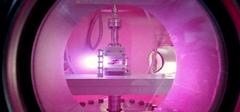URL: https://www.desy.de/news/news_search/index_eng.html
Breadcrumb Navigation
DESY News: Measuring the Wave
News
News from the DESY research centre
Measuring the Wave
The technology of plasma-based acceleration promises to deliver a new generation of powerful and compact particle accelerators. Prior to applying this new technology, however, various obstacles must be overcome. In particular precise control of the acceleration process itself must be achieved. Using an innovative technique researchers at DESY have now succeeded in measuring the accelerating plasma wake with previously unattained precision. Their method allows the shape of the effective accelerating field to be determined with a resolution on the order of femtoseconds (billionths of a millionth of a second) so that the acceleration process can be studied in great detail, thereby paving the way for the controlled and optimised operation of future plasma accelerators, as the team led by DESY’s Jens Osterhoff explains in the journal Nature Communications.

An electron bunch with varying energy (dark blue to orange) drives a plasma wave (white) with strong electric fields (red and blue). Removing thin slices from the tail of the electron bunch in a controlled manner allows the precise measurement of the electric fields. Credit: DESY, Ángel Ferran Pousa
The acceleration produced by the plasma wake can be up to a thousand times greater than that of the strongest conventional systems currently in operation. “To achieve optimal acceleration the electron bunches and the wake need to be precisely tuned to each other,” explains Sarah Schröder, the principal author of the paper, who works at DESY and the University of Hamburg. “To do that you have to be able to measure the shape of the wake precisely and this is very challenging due to its small dimensions, being just a few thousandths of a millimetre long.”
So the team developed a method whereby the accelerated electrons themselves are used to reveal the shape of the plasma wake’s accelerating field. To achieve this, the electron bunch is first rotated by a magnetic chicane. Thin slices can then be removed from the bunch tail by transversely inserting a piece of metal. Finally the electron bunch is rotated back again.

View of the FLASHForward accelerator module. The plasma is generated in the narrow channel in the centre by a high voltage. Credit: DESY, Alexander Knetsch
“For the first time we have precisely measured the effective electric field responsible for the acceleration,” Schröder points out. “Using this technique the interaction between the individual experimental components and the process of acceleration can now be studied in detail.”
Other experimental facilities for plasma acceleration also stand to benefit from the new technology. “Our method is an important step on the path to a detailed understanding of the plasma wake and to optimising it,” explains Osterhoff.
“This experiment demonstrates the exquisite precision that can be achieved in measuring the accelerating fields and paves the way for the new era of control and stability that plasma accelerators are entering,” adds Wim Leemans, Director of DESY’s accelerator division.
Reference:
High-resolution sampling of beam-driven plasma wakefields; S. Schröder, C.A. Lindstrøm, S. Bohlen, G. Boyle, R. D’Arcy, S. Diederichs, M.J. Garland, P. Gonzalez, A. Knetsch, V. Libov, P. Niknejadi, K. Põder, L. Schaper, B. Schmidt, B. Sheeran, G. Tauscher, S. Wesch, J. Zemella, M. Zeng, and J. Osterhoff; Nature Communications, 2020; DOI: 10.1038/s41467-020-19811-9



